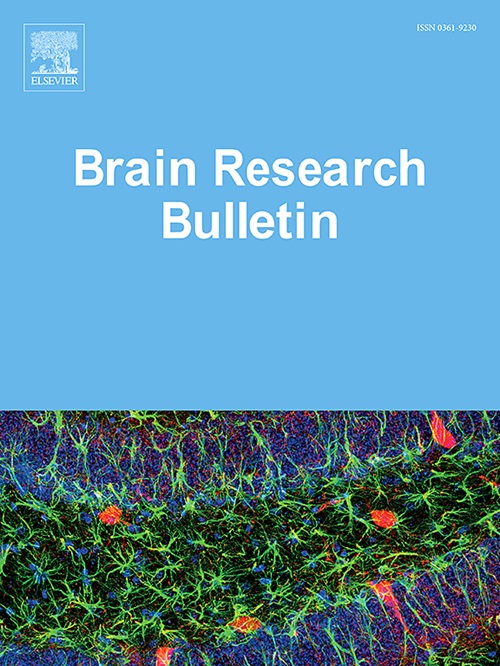MicroRNA-669f-5p targeting deoxycytidinephosphate deaminase contributes to sevoflurane-induced cognitive impairments in aged mice via the TLR2/4–MyD88–NF-κB pathway
IF 3.7
3区 医学
Q2 NEUROSCIENCES
引用次数: 0
Abstract
Background
Postoperative cognitive dysfunction (POCD) is a common complication associated with sevoflurane anaesthesia in the aged population. MicroRNAs have been implicated in sevoflurane-induced cognitive deficits; however, the role and underlying mechanism of microRNA (miR)-669f-5p remain unclear.
Methods
Eighteen-month-old mice and mouse hippocampal neurons (HT22) were exposed to sevoflurane. Cognitive function was assessed using the Morris water maze test. Neuroapoptosis and cellular proliferation were evaluated by terminal-deoxynucleotidyl transferase-mediated nick end-labelling staining and Cell Counting Kit-8 assays, respectively. The downstream molecular mechanisms of miR-669f-5p were investigated using bioinformatics analysis, western blotting, quantitative real-time polymerase chain reaction, immunofluorescence and dual-luciferase reporter assays.
Results
Bioinformatics analysis of the Gene Expression Omnibus database revealed upregulation of miR-669f-5p in hippocampal tissue from mice with POCD. Inhibition of miR-669f-5p substantially improved sevoflurane-induced cognitive impairment in aged mice. Deoxycytidinephosphate deaminase (Dctd) was identified as a direct target of miR-669f-5p. Overexpression of Dctd reversed the effects of miR-669f-5p mimics on apoptosis and proliferation in HT22 cells and suppressed activation of the TLR2/4–MyD88–NF-κB signalling pathway. Moreover, Dctd overexpression ameliorated sevoflurane-induced cognitive impairment in aged mice.
Conclusion
MicroRNA-669f-5p contributes to sevoflurane-induced cognitive impairment in aged mice by targeting Dctd and activating the TLR2/4–MyD88–NF-κB pathway. These findings provide new insights into potential therapeutic strategies for anaesthesia-related POCD.
靶向脱氧胞苷磷酸脱氨酶的MicroRNA-669f-5p通过TLR2/4-MyD88-NF-κB通路参与七氟醚诱导的老年小鼠认知障碍。
背景:术后认知功能障碍(POCD)是老年人七氟醚麻醉的常见并发症。MicroRNAs与七氟醚诱导的认知缺陷有关;然而,microRNA (miR)-669f-5p的作用和潜在机制尚不清楚。方法:将18月龄小鼠和小鼠海马神经元(HT22)暴露于七氟醚中。采用Morris水迷宫试验评估认知功能。分别通过末端脱氧核苷酸转移酶介导的缺口末端标记染色和细胞计数试剂盒-8检测评估神经细胞凋亡和细胞增殖。采用生物信息学分析、western blotting、定量实时聚合酶链反应、免疫荧光和双荧光素酶报告基因检测来研究miR-669f-5p的下游分子机制。结果:基因表达综合数据库的生物信息学分析显示,POCD小鼠海马组织中miR-669f-5p上调。抑制miR-669f-5p可显著改善七氟醚诱导的老年小鼠认知功能障碍。脱氧胞苷磷酸脱氨酶(Dctd)被确定为miR-669f-5p的直接靶标。Dctd过表达逆转了miR-669f-5p模拟物对HT22细胞凋亡和增殖的影响,抑制了TLR2/4-MyD88-NF-κB信号通路的激活。此外,Dctd过表达可改善七氟醚诱导的老年小鼠认知功能障碍。结论:MicroRNA-669f-5p通过靶向Dctd,激活TLR2/4-MyD88-NF-κB通路参与七氟醚诱导的老年小鼠认知功能障碍。这些发现为麻醉相关POCD的潜在治疗策略提供了新的见解。
本文章由计算机程序翻译,如有差异,请以英文原文为准。
求助全文
约1分钟内获得全文
求助全文
来源期刊

Brain Research Bulletin
医学-神经科学
CiteScore
6.90
自引率
2.60%
发文量
253
审稿时长
67 days
期刊介绍:
The Brain Research Bulletin (BRB) aims to publish novel work that advances our knowledge of molecular and cellular mechanisms that underlie neural network properties associated with behavior, cognition and other brain functions during neurodevelopment and in the adult. Although clinical research is out of the Journal''s scope, the BRB also aims to publish translation research that provides insight into biological mechanisms and processes associated with neurodegeneration mechanisms, neurological diseases and neuropsychiatric disorders. The Journal is especially interested in research using novel methodologies, such as optogenetics, multielectrode array recordings and life imaging in wild-type and genetically-modified animal models, with the goal to advance our understanding of how neurons, glia and networks function in vivo.
 求助内容:
求助内容: 应助结果提醒方式:
应助结果提醒方式:


